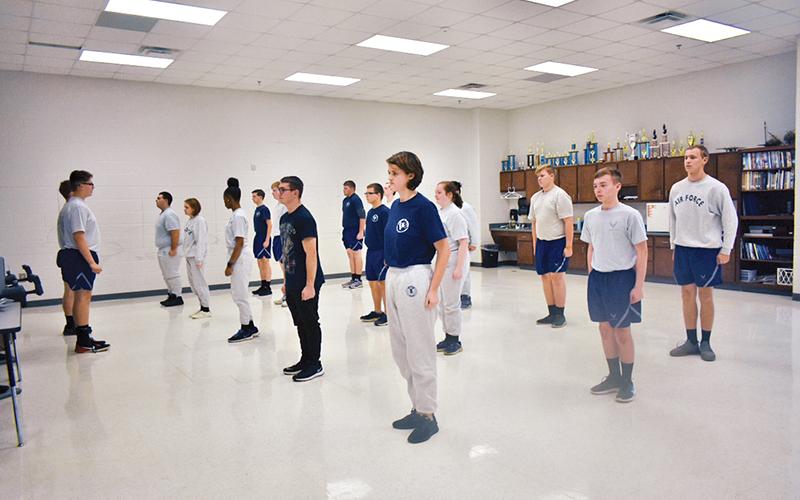The Air Force Junior Reserve Officer Training Corps began at Habersham Central High School in 2006. Since then, Major Etoya Hearon said the program has grown in terms of the opportunities they’ve had to participate in more challenging events.
“We have students that are really dedicated and who are looking at military related careers,” she said. “I think that may be a big difference. One thing about Air Force Junior ROTC is that the mission is not to recruit. I’m not sure everybody knows that.”
Hearon said the mission is to develop citizens of character dedicated to serving their nation and community.
This semester, there are 73 students in the program who meet 90 minutes a day Monday through Friday. It is open to students in ninth grade and above.
Master Sgt. Robert Wallace, aerospace science instructor, helped start the program at the high school. He said the students now are self-starters, more so than earlier on.
“We developed a culture of leadership as opposed to from the ninth graders to the 10th graders we don’t have to reinvent the wheel,” he said. “That’s probably one of the biggest changes. When I started, it was just 10th, 11th and 12th, so trying to incorporate ninth graders has been kind of a challenge along the way. … Now, I would say we have a pretty strong base of self-starting leaders. It’s not so much that we have to micromanage them.”
As in line with the mission, two things Hearon and Wallace stress in the program is community involvement and leadership skills.
The cadet staff, for example, is responsible for planning, organizing and executing leadership activities. Students participate in flag raisings, veterans events, all home games and more.
“I want the community to know that young people are doing a lot of positive things and also that young people are developing leadership roles,” Hearon said about the importance of being visible in the community. “Sergeant Wallace and I do everything we can to put them out front. We try very much to be behind them. If it’s a color guard event, they need to plan it. They need to decide or recommend which uniform to wear, etc.”
Similar to the hierarchy in sports or the band, Wallace said Air Force JROTC is another pathway where students can gain leadership experience. And that’s something they will carry with them for the rest of their lives and into their careers.
“Without fail, all of them when they go to apply for a job and they’ve got JROTC on there all the employers know that as part of their experience they’re going to be polite, they’re generally going to be timely, they know how to look professional,” Wallace said.
Hearon added that a neat thing about Air Force JROTC is that it’s not just about having students march.
“We teach them aerospace science, milestones in aviation history, we’re working on the science of flight,” she said. “That’s the curriculum. They also … learn principals of leadership, effective speaking, effective writing, etc. … If nothing else, we want people to know it’s a cadet-led program. The students will learn how to be good leaders and followers, because not everyone is going to be a leader, some are going to be followers. They’ll learn how to handle situations. We talk about stress management and things like that, so it’s a pretty open curriculum.”
This year, three students applied for the Air Force JROTC Flight Academy, which Hearon says she counts as an accomplishment for the program. If selected, the students will receive free pilot training. Last year, only a few were selected out of over 2,000 students who applied.
Two of the students who applied this year were 11th-graders and squadrons Sterlin Goodson and William Sorrows. Both students said they initially joined the Air Force JROTC program because they were interested in a military career, but later learned about other opportunities and now would like to commission as officers.
Again, Goodson said a common misconception about the program is that there is a military commitment when there’s not. Hearon and Wallace said very few students actually enlist after they graduate. The focus is in fulfilling the mission.

